Special Report
Every Standard Issue US Military Rifle Since the American Revolution

Published:
Last Updated:

In any war, even the smallest advantage can mean the difference between victory and defeat. To maintain the upper hand, the Department of Defense spent $106 billion on research and development of weapons technology in 2021 alone. And while new and evolving technologies like precision guided missiles and drones have changed battlefield dynamics in recent years, outfitting troops with rifles that are reliable and effective remains a top priority – as it has since America’s founding.
Perhaps second only to the will to fight, the rifle is the most important asset of any army infantry soldier. And from the flintlock muskets used by the Continental Army in the American Revolution, to the M4 assault rifles carried by U.S. Army infantry units of today, weapons technology has evolved considerably over the nearly 250 years the U.S. has been a country.
Using data from a range of sources, including military records and government websites, 24/7 Wall St. identified standard-issue and other common infantry rifles issued by the U.S. Army throughout history – starting with the Colonial period. We did not include rifles with specialized functions, such as sniper rifles and machine guns. (Here is a look at the 9 fastest firing machine guns in the world.)
From the American Revolution through the Civil War, rifle technology changed little. Over that nearly 100-year period, American soldiers were issued muskets that were limited in range, accuracy, and reliability by any modern standard. Though there were some innovations during that period, including the rifled barrel and the switch from a flintlock firing mechanism to caplock, it was not until the 1870s, with the introduction of the Model 1873 Springfield, which fired a bullet with a self-contained cartridge, that the U.S. Army adopted anything resembling what we use today.
Even then, the M1873 was a single-shot rifle, with a maximum rate of fire of about 15 rounds per minute. For comparison, modern military rifles can cycle at a rate of about 950 rounds per minute. (Here is a look at every firearm currently used by the U.S. military.)
In the 20th century, the standard-issue rifle of the U.S. Army made a difference in battle on multiple occasions – both for better and for worse. In the Spanish-American War, for example, American troops carrying the M1892 Krag-Jorgensen were outgunned by Spanish troops equipped with German Mausers. Conversely, the semiautomatic M1 Garand issued to American troops in the Second World War gave American soldiers a clear advantage over German and Japanese troops carrying bolt-action rifles.
Click here to see every standard issue US military rifle since the American Revolution.
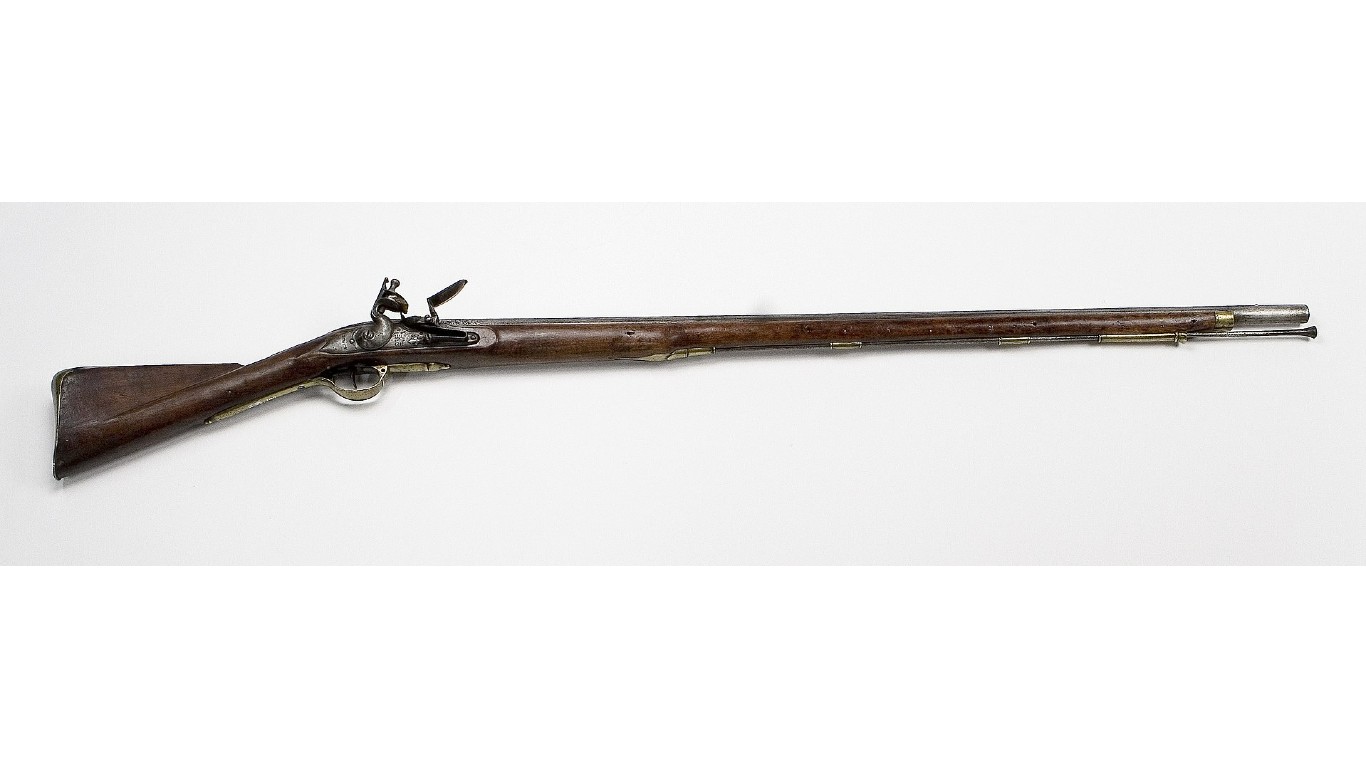
1. British Land Pattern Musket “Brown Bess”
> Action type: Flintlock
> Caliber: .75
> Primary conflict(s): American Revolution – War of 1812
> Manufactured by: Great Britain and American gunsmiths
The British Land Pattern Musket – more commonly known as “Brown Bess,” a nickname of unknown origin – was the most commonly used firearm in the American Revolution. British-made versions of the flintlock musket were carried by both sides in the conflict, though the Continental Army also carried versions that were domestically manufactured by gunsmiths who copied the design. Brown Bess was used again by opposing U.S. and British forces in the War of 1812.
[in-text-ad]

2. Charleville Model 1763 & 1766 muskets
> Action type: Flintlock
> Caliber: .69
> Primary conflict(s): American Revolution – War of 1812
> Manufactured by: France
During the Revolutionary War, France supplied the Continental Army with over 25,000 Model 1763 Charleville muskets and thousands of additional Charleville 1766. These muskets fired slightly smaller projectiles than the Brown Bess musket, chambered in .69 caliber compared to .75. They had a maximum effective range of only about 100 yards and could be fired at a rate of three rounds per minute by an experienced soldier.
Though manufactured in France, General George Washington had the Charlevilles stamped as U.S. property in an effort to reduce theft.
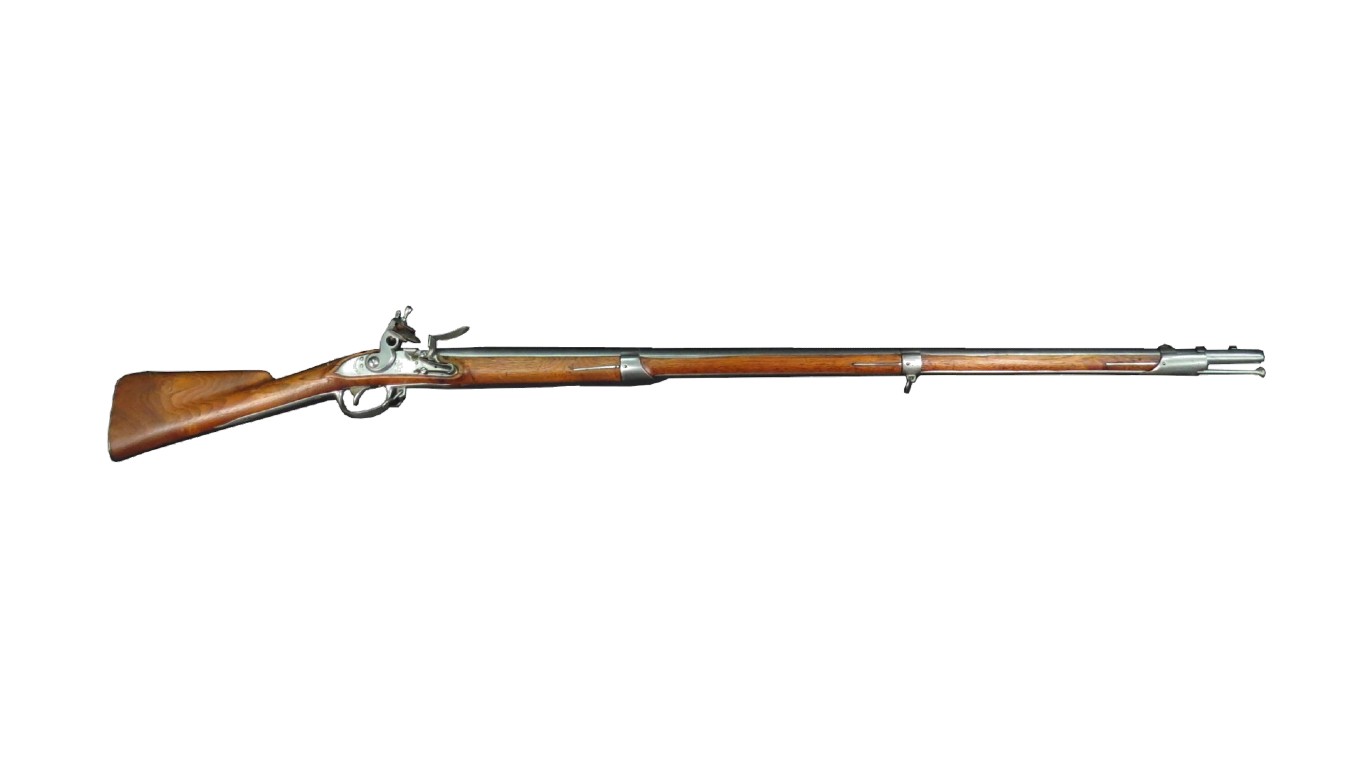
3. Springfield U.S. Model muskets (1795-1841 model year variants)
> Action type: Flintlock (some later models were converted to caplock)
> Caliber: .69
> Primary conflict(s): War of 1812 – Civil War
> Manufactured by: Springfield Armory, Harpers Ferry Armory
From the late 18th to the mid-19th centuries, the United States military was outfitted with several models of the Springfield U.S. musket. These muskets borrowed many of the design elements of the Charleville muskets supplied by the French, and were even chambered for the same .69 caliber musket ball.
Manufactured primarily at the Springfield Armory in Massachusetts, the Springfield U.S. Model 1795 musket was the first official musket of the U.S. military. Initially produced as flintlock, many Springfield muskets were eventually converted to function with a percussion cap – a new technology at the time that improved reliability, weather resistance, and ease of loading.
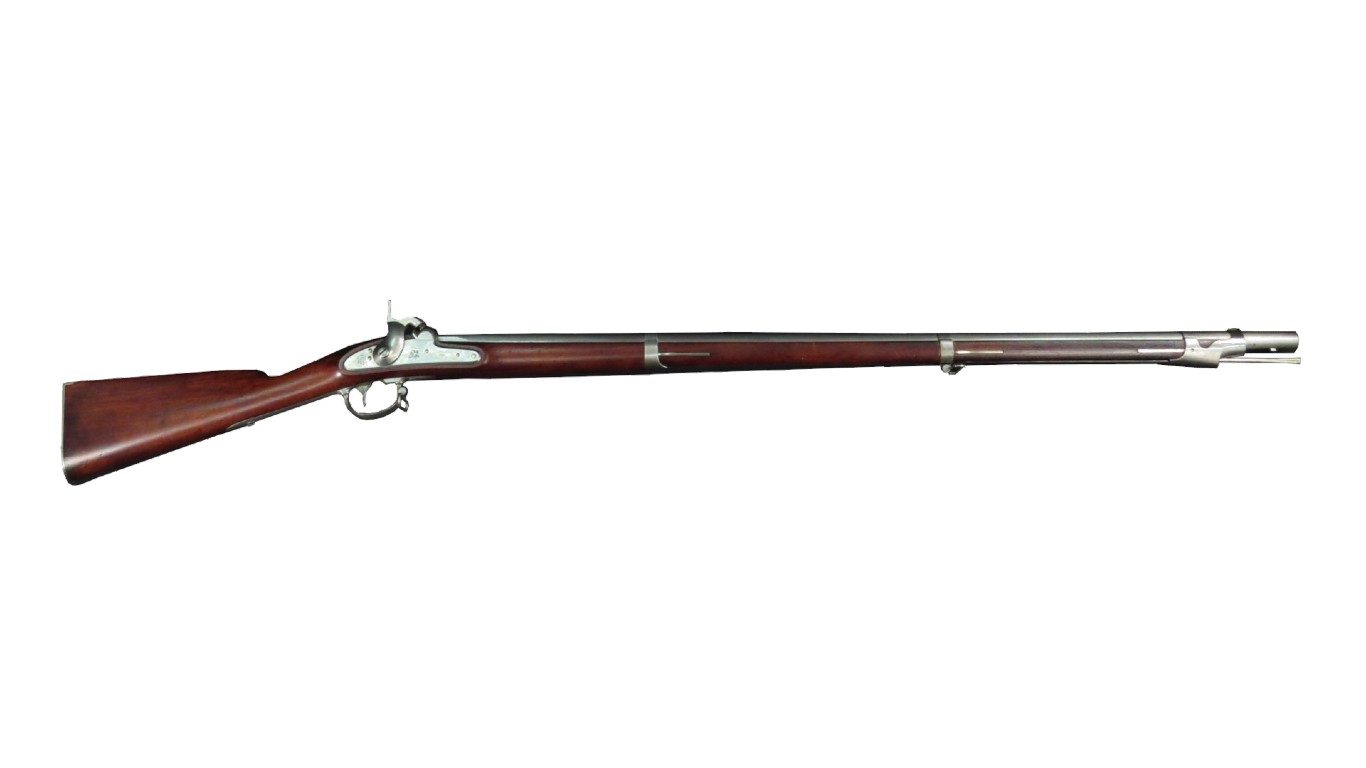
4. U.S. Model 1842 musket
> Action type: Caplock
> Caliber: .69
> Primary conflict(s): Mexican-American War – Civil War
> Manufactured by: Springfield Armory, Harpers Ferry Armory
The U.S. Model 1842 musket is recognized as the first regulation musket in the United States built to be used exclusively with a caplock system, rather than the antiquated flintlock design. Mass produced, these guns also had interchangeable parts, making for easier repairs. Armories at both Springfield and Harpers Ferry produced about 275,000 Model 1842 between 1843 and 1855.
The Model 1842 musket was widely used in the Mexican-American War and by both Union and Confederate forces in the Civil War.
[in-text-ad-2]
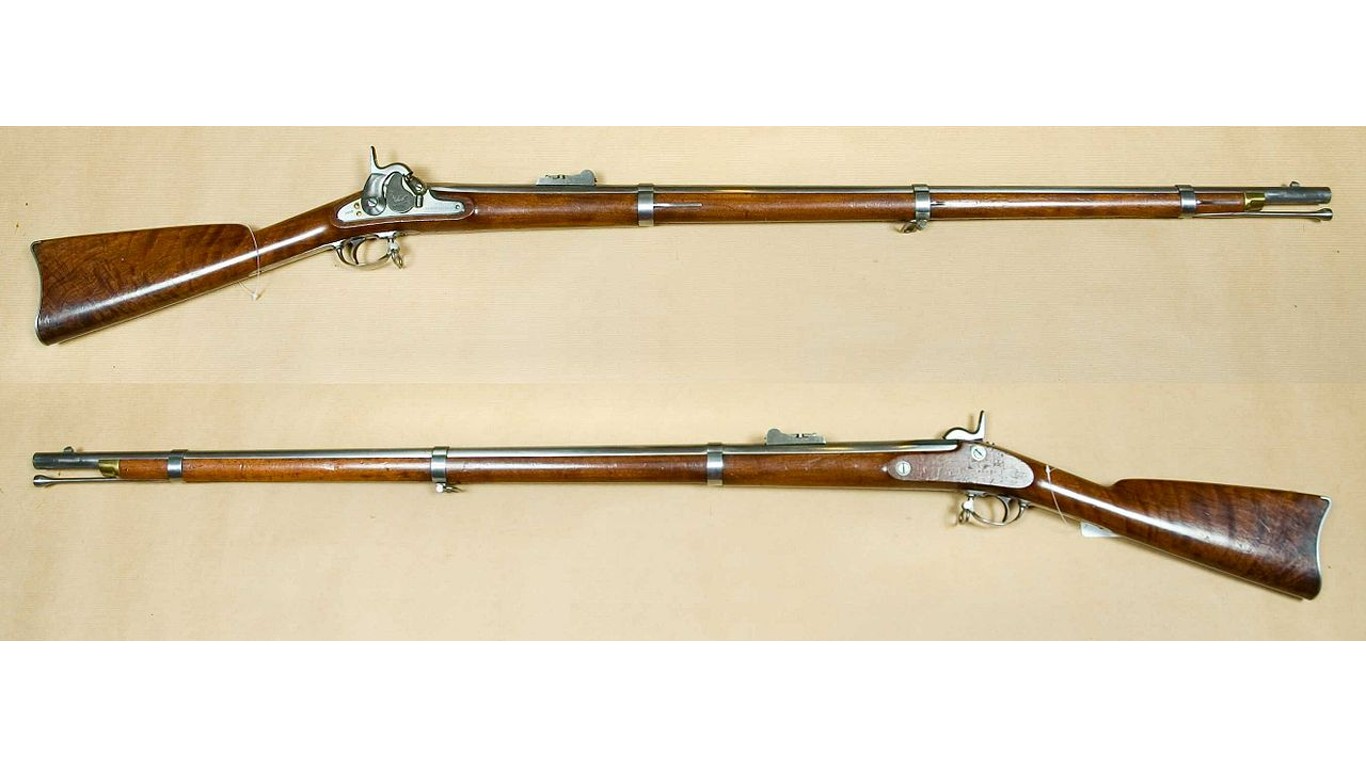
5. U.S. Models 1855 and 1861 Springfield rifle-muskets
> Action type: Caplock
> Caliber: .58
> Primary conflict(s): Civil War
> Manufactured by: Springfield Armory, Harpers Ferry Armory, other private contractors
The Model 1855 Springfield musket was the first U.S. regulation firearm to use a rifled barrel rather than the less accurate smoothbore barrel. Also, rather than a ball, the Model 1855 fired a conical bullet, further improving accuracy and range. The Model 1855 rifled musket replaced the Model 1842 as the standard issue Army firearm in July 1855. From 1857 to 1860, the Springfield and Harpers Ferry armories produced nearly 54,200 M1855 rifle muskets.
The M1855 had a flawed percussion firing system, however, and was ultimately replaced by the improved Model 1861, which was the standard issue firearm during the Civil War. Originally produced by the Springfield Armory, the U.S. government contracted 20 other private gunmakers, which, together, produced an estimated 1 million M1861 rifle muskets throughout the war.
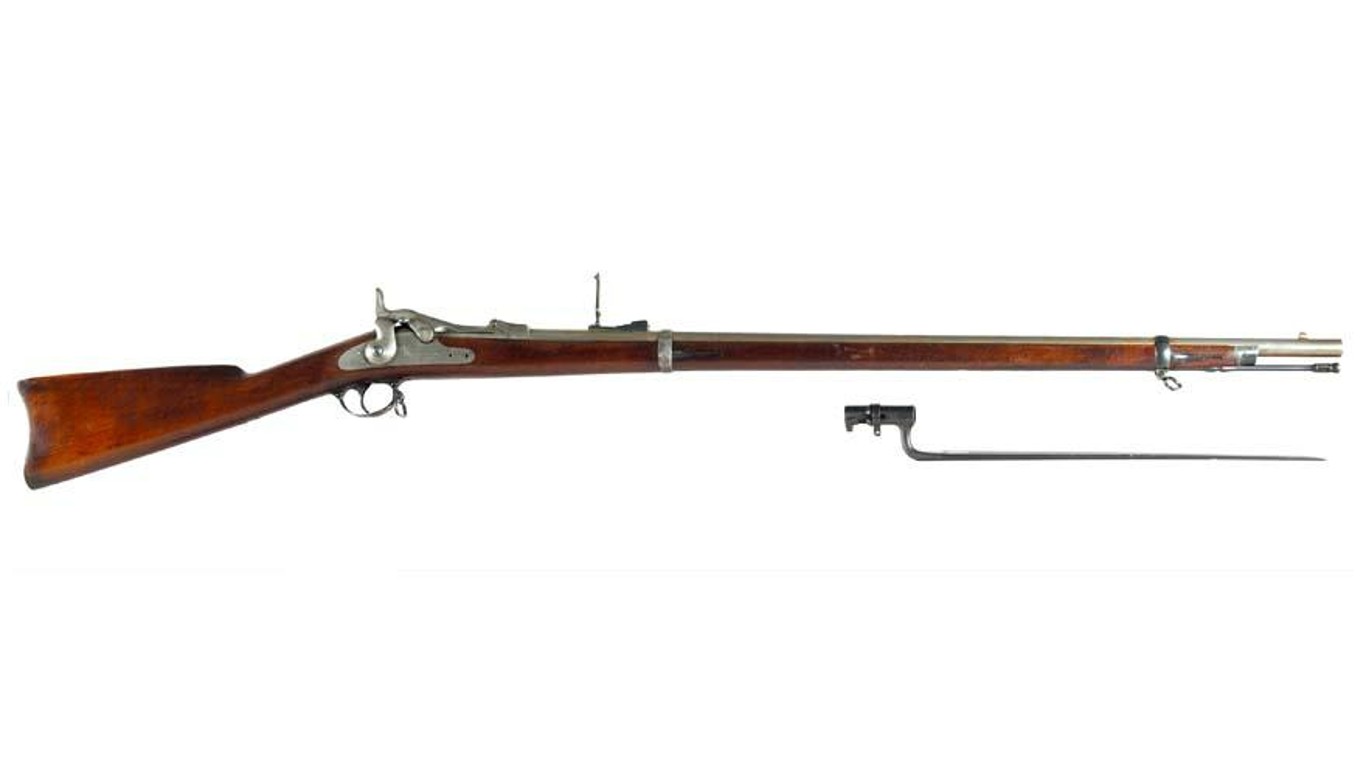
6. Model 1873 Springfield
> Action type: Single shot, trapdoor
> Caliber: .45-70
> Primary conflict(s): American Indian Wars
> Manufactured by: Springfield Armory
The Model 1873, also known as the “Trapdoor Springfield,” marked a leap in technological advancement for American military rifles. It was loaded from the breech of the gun rather than from the muzzle through a trapdoor system, and just like modern rifles, the M1873 also used a bullet with a self-contained cartridge.
The new rifle allowed an experienced soldier to fire up to 15 rounds per minute, a drastic improvement from earlier muskets. Not only powerful, the M1873 also had an effective range of up to 1,000 yards with a well-trained user. Used in the American-Indian Wars, M1873 were also used in the Spanish-American War and the Philippine Insurrection.
[in-text-ad]

7. Model 1892 Krag-Jorgensen
> Action type: Bolt
> Caliber: .30-40 Krag
> Primary conflict(s): Spanish-American War, Philippine-American War
> Manufactured by: Springfield Armory
With the introduction of lever-action repeaters, like those associated with the old American West, the single shot Trapdoor Springfield was becoming obsolete, and in 1892, the U.S. military replaced it with the Model 1892 Krag-Jorgensen. The M1892 was the first standard issue rifle in the American military to use smokeless powder and also the first with a bolt-action design. The gun was fed through a five-round rotary magazine located on the side of the rifle.
Several variants of the Krag were introduced before the turn of the century, including the M1896 and M1898 rifles, as well as the smaller M1896, M1898, and M1899 carbines.
8. Springfield Model 1903
> Action type: Bolt
> Caliber: .30-06
> Primary conflict(s): World War I
> Manufactured by: Springfield Armory, Rock Island Armory
When the Krag-Jorgensen was deployed in the Spanish-American War, it was deemed inferior to the Mauser rifles used by Spanish troops, which led to the development of the Springfield M1903 – a rifle that borrowed heavily from the Mauser’s design.
Initially chambered with a .30-03, the M1903 was eventually converted to accept the more effective, and still popular, .30-06 round. The M1903 was the standard issue U.S. military rifle during World War I, and by the time the U.S. entered the war, over 843,000 had been manufactured. However, insufficient hardening of receivers caused many to fail in combat. The issue was later corrected, and between 1905 and 1949, more than 1.3 million M1903s were produced, many of which were used as sniper rifles during the Second World War.

9. Model 1917 Enfield
> Action type: Bolt
> Caliber: .30-06
> Primary conflict(s): World War I
> Manufactured by: Eddystone, Remington and Winchester
The most commonly issued rifle to American troops in World War I was the Model 1917 Enfield, also known as the American Enfield. Using a British design, altered slightly to accommodate .30-06 ammunition, Eddystone, Remington, and Winchester manufacturing plants churned out some 2.2 million bolt-action M1917 Enfields from 1914 to 1918.
Both simpler in design and cheaper to make than the M1903, the M1917 made up as many as 75% of guns carried by the American Expeditionary Force in France during the Great War.
[in-text-ad-2]
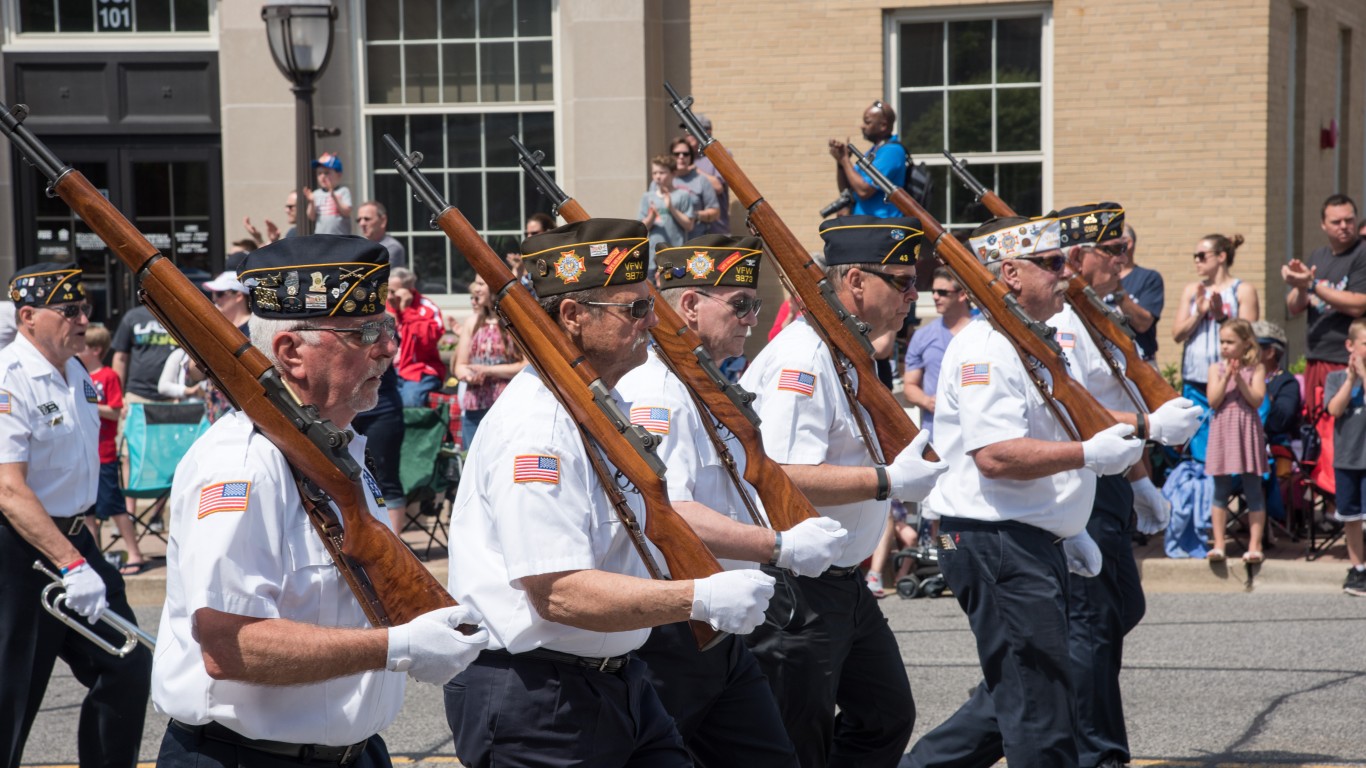
10. M1 Garand
> Action type: Semiautomatic
> Caliber: .30-06
> Primary conflict(s): World War II, Korean War, Vietnam War
> Manufactured by: Springfield Armory, Winchester, International Harvester Co., Harrington & Richardson
Described by Gen. George Patton as “the greatest battle implement ever devised,” the M1 Garand gave U.S. soldiers and Marines a distinct advantage in World War II. Developed between WWI and WWII, the M1 was a semiautomatic rifle that boasted a firing rate of 30 rounds per minute. It is widely regarded as among the best infantry rifles deployed in WWII.
The M1 Garand went on to serve U.S. troops in the Korean War and the Vietnam War, though in a more limited capacity. From the mid-1930s through the mid-1950s, Springfield Armory and other private contractors manufactured nearly 5.5 million M1 rifles.

11. M14
> Action type: Semiautomatic and selective fire
> Caliber: 7.62 mm
> Primary conflict(s): Vietnam War
> Manufactured by: Springfield Armory, Winchester, and Harrington & Richardson
The M1 Garand was replaced as the standard issue U.S. military rifle by the M14 rifle in 1960. Though it borrowed features from the Garand – including the bolt, receiver, and sights – the M14 had a selective fire feature, allowing it to fire multiple rounds with a single trigger pull. Like many modern military rifles, it also used a detachable box magazine.
Introduced after the Korean War, the M14 was carried by American troops during the intervention in the Dominican Civil War and the early years of Vietnam. Some M14s are still used by military marksmen.
[in-text-ad]

12. M16
> Action type: Semiautomatic and selective fire
> Caliber: 7.62 and 5.56 mm
> Primary conflict(s): Vietnam War, Gulf War, Iraq War
> Manufactured by: Colt, FN Manufacturing
For much of the Vietnam War, the M16 was the standard issue rifle for American troops. Using aluminum and other composite materials, the M16 is relatively lightweight and capable of firing 700-900 rounds per minute. Early versions of the rifle were prone to jamming, malfunction, and other problems, which were largely addressed in later models.
M16s can be outfitted with accessories, including bayonets, grenade launchers, scopes, and flashlights. Later variations of the rifle included a three-round burst option, in addition to fully- and semi- automatic modes. Though the M16 is no longer the standard issue, it is still widely used in the military.
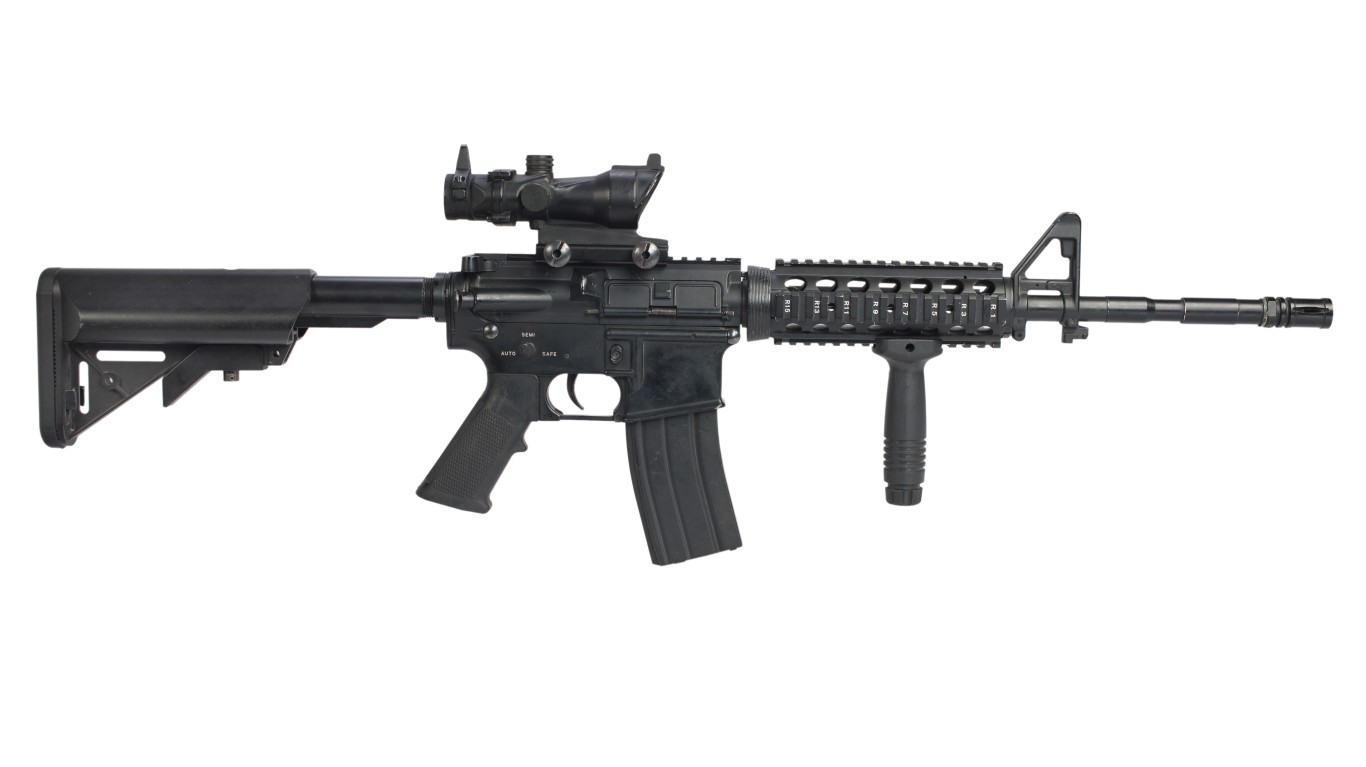
13. M4 carbine
> Action type: Semiautomatic and selective fire
> Caliber: 5.56 mm
> Primary conflict(s): Iraq War, War in Afghanistan
> Manufactured by: Colt, Remington, Norinco, Bushmaster
The M4 carbine and subsequent variants have been the standard issue rifle in the U.S. Army since the early 2000s. Essentially a scaled down version of the M16, the M4 is lightweight and offers comparable firepower. Typically equipped with a 30-round detachable magazine, M4s have selective fire capabilities and can cycle at a rate of 700 to 950 rounds per minute.
Choosing the right (or wrong) time to claim Social Security can dramatically change your retirement. So, before making one of the biggest decisions of your financial life, it’s a smart idea to get an extra set of eyes on your complete financial situation.
A financial advisor can help you decide the right Social Security option for you and your family. Finding a qualified financial advisor doesn’t have to be hard. SmartAsset’s free tool matches you with up to three financial advisors who serve your area, and you can interview your advisor matches at no cost to decide which one is right for you.
Click here to match with up to 3 financial pros who would be excited to help you optimize your Social Security outcomes.
Have questions about retirement or personal finance? Email us at [email protected]!
By emailing your questions to 24/7 Wall St., you agree to have them published anonymously on a673b.bigscoots-temp.com.
By submitting your story, you understand and agree that we may use your story, or versions of it, in all media and platforms, including via third parties.
Thank you for reading! Have some feedback for us?
Contact the 24/7 Wall St. editorial team.